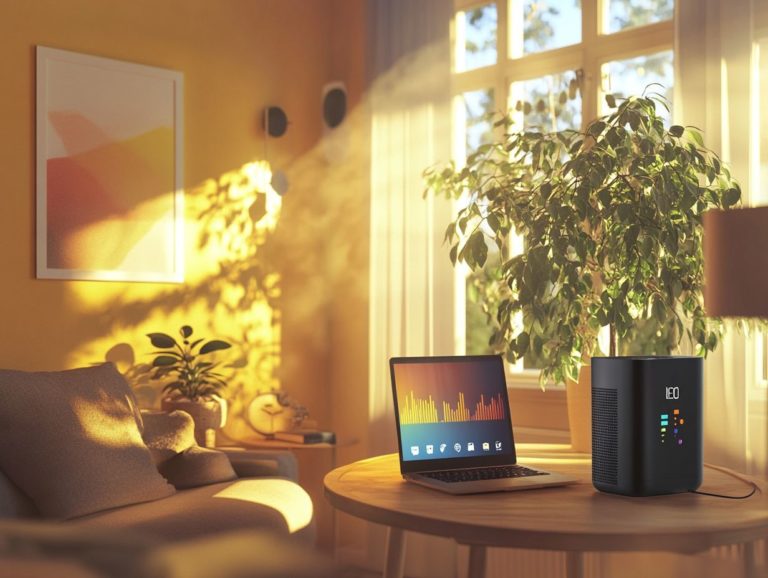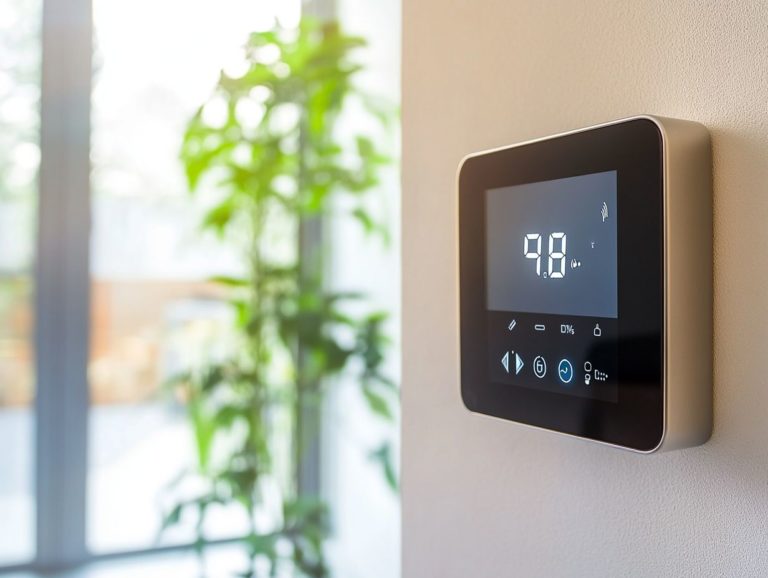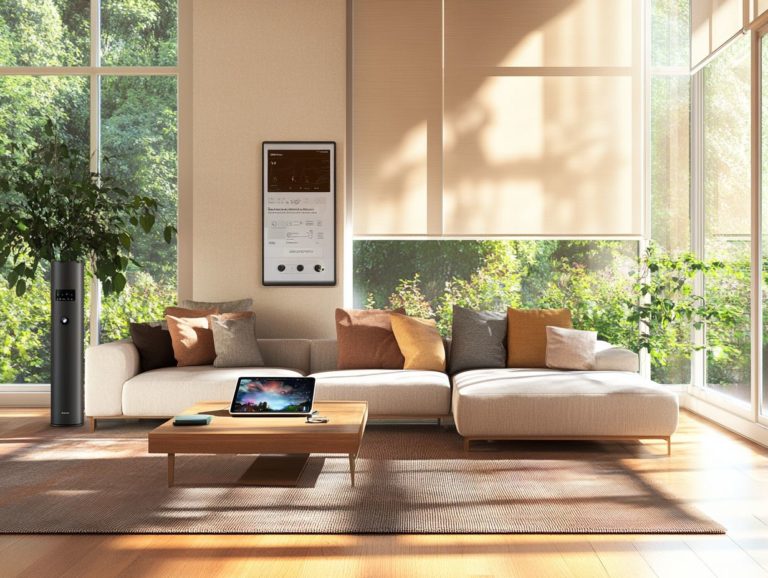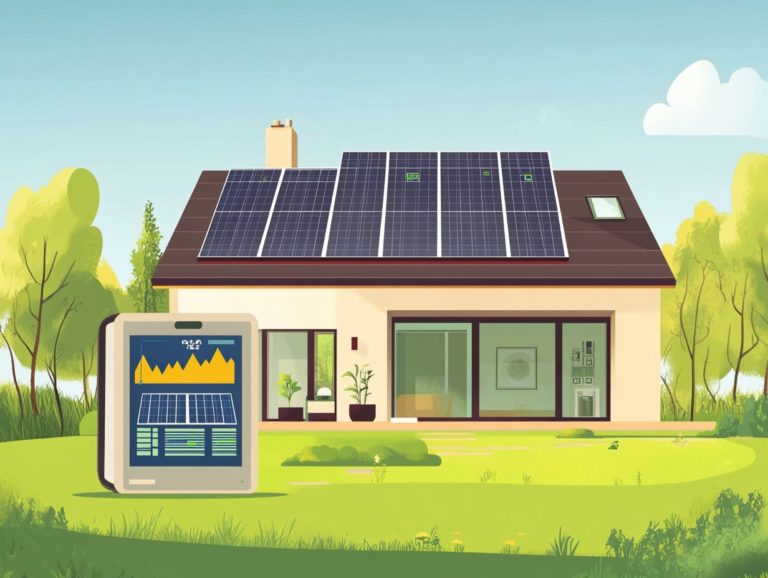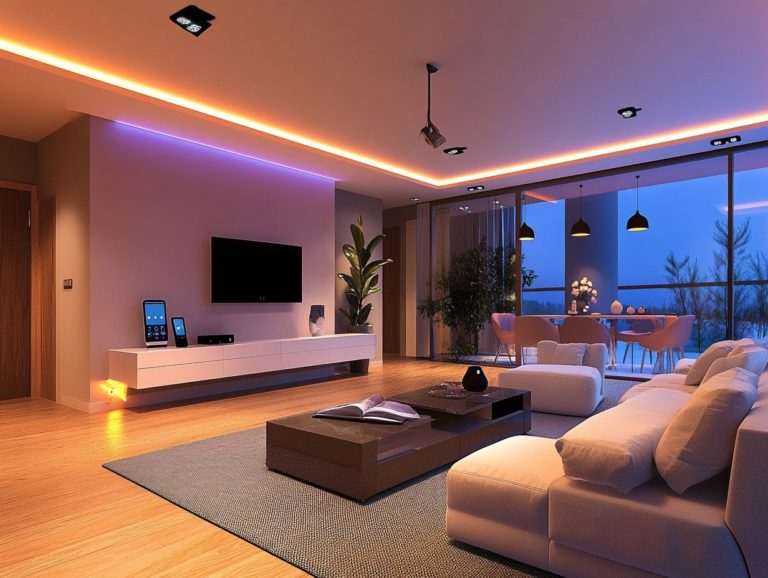How to Choose Energy-Efficient Smart Devices
In today’s tech-savvy world, smart home devices are revolutionizing the way you live, work, and play. As these innovative gadgets become more prevalent, grasping their energy efficiency becomes essential not just for your wallet, but for the environment too.
This article delves into what truly defines an energy-efficient device, the key factors to consider when selecting smart home devices, and how to evaluate their energy consumption. With practical tips for minimizing energy use and insights into the myriad benefits of energy-efficient technology, you ll be well-equipped to make informed choices that enhance both sustainability and savings through smart energy solutions.
Explore how your smart decisions can pave the way for a brighter, greener future.
Contents
- Key Takeaways:
- Understanding Energy Efficiency in Smart Devices
- Factors to Consider when Choosing Energy-Efficient Smart Devices
- How to Determine the Energy Consumption of a Smart Device
- Tips for Reducing Energy Consumption in Smart Devices
- Benefits of Choosing Energy-Efficient Smart Devices
- Frequently Asked Questions
- How do smart home hubs integrate with other devices?
- What are energy-efficient smart devices?
- Why is it important to choose energy-efficient smart devices?
- How do I identify energy-efficient smart devices?
- What are the best energy-saving features to look for in smart devices?
- How can I compare the energy efficiency of different smart devices?
- Are all energy-efficient smart devices expensive?
Key Takeaways:
- Understanding energy efficiency is key to choosing the right smart devices.
- Factors like ENERGY STAR ratings, power usage, and features should be considered when deciding on energy-efficient devices.
- Calculating energy consumption and adjusting settings can help reduce energy usage and save money while benefiting the environment.
Understanding Energy Efficiency in Smart Devices
Understanding energy efficiency in smart devices is essential, as it significantly influences your energy consumption and overall energy costs.
With the surge of smart home technology think smart thermostats, smart lighting, and smart appliances homeowners like yourself are increasingly focused on managing energy use and home automation.
Embracing intelligent solutions for heating and cooling can help you reduce energy usage significantly. You can enjoy comfort and convenience while adopting eco-friendly practices.
This journey into energy efficiency will unveil how interconnected devices can lead to smarter energy solutions and lower bills. Join the movement towards a sustainable environment for future generations!
What Makes a Device Energy Efficient?
Smart home products like smart thermostats, smart lighting systems, and smart plugs can greatly enhance energy efficiency.
A device is deemed energy efficient when it consumes less energy to perform the same tasks as its less efficient counterparts, ultimately leading to lower energy consumption and reduced energy bills. Look for features like ENERGY STAR ratings, which signify that a product adheres to stringent energy efficiency standards set by the U.S. Environmental Protection Agency, helping you make eco-friendly choices. Brands like Ecobee and Nest often meet these standards.
Energy efficiency encompasses a variety of attributes, often including advanced technologies that minimize waste and optimize energy usage. For example, appliances with variable speed motors or high-efficiency heat exchangers which efficiently transfer heat without wasting energy showcase impressive energy conservation capabilities.
Smart devices, like smart thermostats and smart lighting systems, take energy efficiency up a notch by intelligently adjusting usage based on real-time data and your preferences. These innovations not only aid in reducing energy consumption but also empower you to make informed decisions about your usage patterns. By embracing such cutting-edge technologies aligned with energy-efficient smart home design principles, you can significantly enhance energy savings while gaining greater control over your environmental impact. Devices like the Rachio smart sprinkler and integrated solar panels further augment these benefits.
Factors to Consider when Choosing Energy-Efficient Smart Devices
When you re selecting energy-efficient smart devices, it s essential to consider several factors to guarantee optimal performance and energy savings. Start by looking at ENERGY STAR ratings, as these indicate compliance with stringent energy efficiency standards.
Pay attention to power usage and energy consumption metrics, which provide insight into a device’s operational costs. By understanding these elements, you can choose smart devices that not only elevate your home automation experience but also contribute to substantial energy reduction over time. For more information, consider exploring smart home automation and energy savings. Brands like Samsung SmartThings and Philips Hue offer devices that integrate seamlessly for better energy management.
Energy Star Ratings
ENERGY STAR ratings provide an essential benchmark for energy-efficient devices, signifying that a product meets or exceeds the energy efficiency guidelines established by the U.S. Environmental Protection Agency. Smart appliances, ranging from intelligent thermostats to LED bulbs, frequently bear these ratings. This allows you to make informed choices that lead to reduced energy consumption and lower energy bills.
The importance of these ratings is profound. They enable you to contribute to environmental sustainability while enjoying significant cost savings. Commonly rated devices, such as refrigerators, washing machines, and air conditioners, play a vital role in your everyday household. Brands like Flo by Moen offer additional water management features.
Consider a smart refrigerator with an ENERGY STAR label. It not only consumes less energy but may also come equipped with features like temperature management and energy usage tracking, further enhancing its efficiency. Similarly, energy-saving smart thermostats can optimize heating and cooling schedules, ensuring your comfort without unnecessary energy expenditure.
By choosing these certified products, you help promote a healthier planet. You also enjoy energy-saving benefits.
Power Usage and Consumption
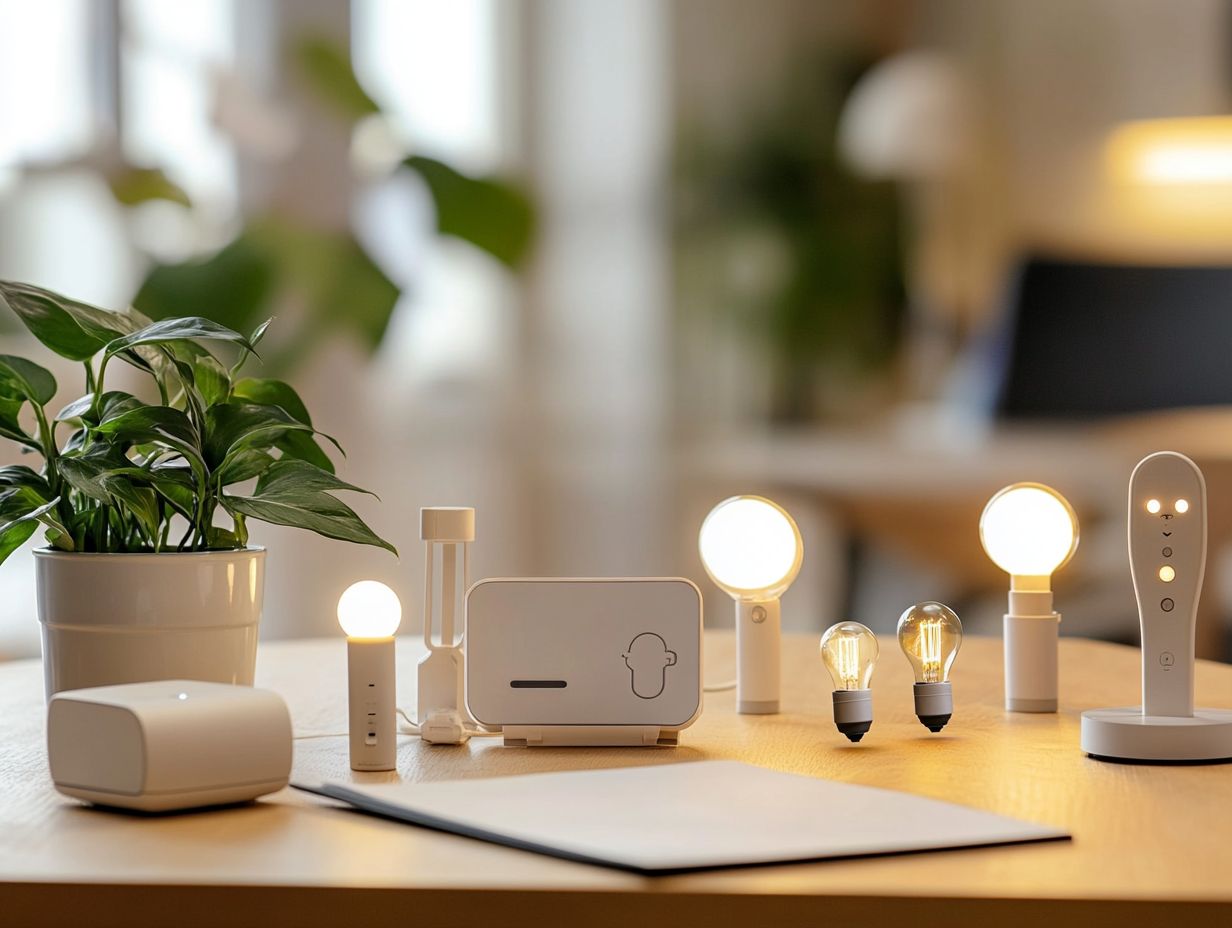
Power usage and consumption are essential metrics to consider when evaluating the energy efficiency of smart devices. They have a direct impact on your overall energy costs. Devices equipped with real-time monitoring features allow you to track energy usage, adjust settings for optimal efficiency, and receive insights through mobile apps.
By integrating smart technology like energy-efficient thermostats and smart plugs you can gain valuable insights into your consumption patterns and pinpoint areas for improvement. For instance, a smart thermostat learns your household routines and automatically adjusts heating or cooling, drastically reducing energy waste. Smart plugs can schedule devices to run during off-peak hours, further slashing your energy bills.
Embrace these innovative solutions to dramatically improve your energy savings! Not only do they elevate your personal energy efficiency, but they also contribute to broader sustainability efforts by decreasing the overall demand on energy systems. Brands like Google Assistant and Amazon Alexa can integrate with your smart home hub for seamless control.
Features and Functions
The features and functions of smart devices are crucial for enhancing energy efficiency. They offer automation systems that streamline your energy management. For instance, imagine having a smart thermostat that detects occupancy and adjusts heating and cooling based on real-time usage. This can lead to significant reductions in energy consumption.
Consider smart lighting systems with motion sensors that automatically turn off lights in unoccupied rooms, effectively cutting unnecessary power usage. Smart plugs allow you to schedule when devices power on or off, ensuring that appliances operate only when absolutely necessary. Smart bulbs like those from Philips Hue can also be controlled via voice commands through your voice assistant.
Think about smart irrigation systems that optimize watering schedules based on weather forecasts. These systems allow for the conservation of both water and energy. The integrated systems work together seamlessly, providing you with a cohesive energy management experience that you can monitor right from your mobile applications. Brands like Rachio and Flo by Moen offer advanced water management solutions that integrate with your smart home network.
Act now to cut your energy bills and make a positive impact on the environment! By effectively leveraging such smart devices, you can take proactive measures toward reducing your energy bills and minimizing your environmental impact. Consider integrating these top smart home devices for eco-friendly living into your home network using technologies such as Zigbee or Z-Wave, which help connect smart devices easily and efficiently.
Explore the latest energy-efficient smart devices today and learn how to choose energy-efficient windows to transform your home energy usage!
How to Determine the Energy Consumption of a Smart Device
To determine the energy consumption of a smart device, you will want to employ energy monitoring tools that accurately measure electricity usage over time. By analyzing this data, you can uncover valuable insights into your power consumption patterns and make adjustments through customizable features that let you set specific times for your devices to run.
This knowledge gives you the power to make informed decisions on optimizing your energy management practices, ultimately leading to a reduction in your overall energy bills.
Calculating Energy Usage and Cost
Calculating the energy usage and associated costs of your smart devices is vital for gaining a comprehensive understanding of your household’s energy consumption and finding ways to save. By using energy monitoring tools, you can track the energy costs of each device and adjust your usage habits accordingly.
With these advanced technologies at your fingertips, you can easily access real-time data, set usage alerts, and even receive tailored suggestions to help minimize your electricity bills. For example, many smart devices come equipped with mobile apps that not only visualize your energy consumption trends but also offer insights into your peak and off-peak hours. With this valuable information, you can strategically shift energy-intensive tasks, such as running the dishes or doing laundry, to off-peak times when rates are lower. Brands like Ecobee and Philips Hue offer user-friendly interfaces for better energy management.
By regularly checking your usage, you’ll find chances to upgrade to more energy-efficient devices, further slashing your overall costs. By incorporating these practices into your daily routine and using smart products like smart power strips, you can significantly reduce your energy expenses while embracing a more sustainable lifestyle. Additionally, consider learning how to optimize energy use with smart home tech for even greater efficiency.
Tips for Reducing Energy Consumption in Smart Devices
You can easily cut down on energy use with a few smart tricks! Consider integrating smart home hubs like Google Assistant or Amazon Alexa for centralized control of your smart home.
By optimizing your device settings, utilizing energy management tools, and taking advantage of features like customizable scheduling, you can significantly lower your energy consumption while still reaping the benefits of home automation and smart energy solutions.
Optimizing Settings and Usage Habits
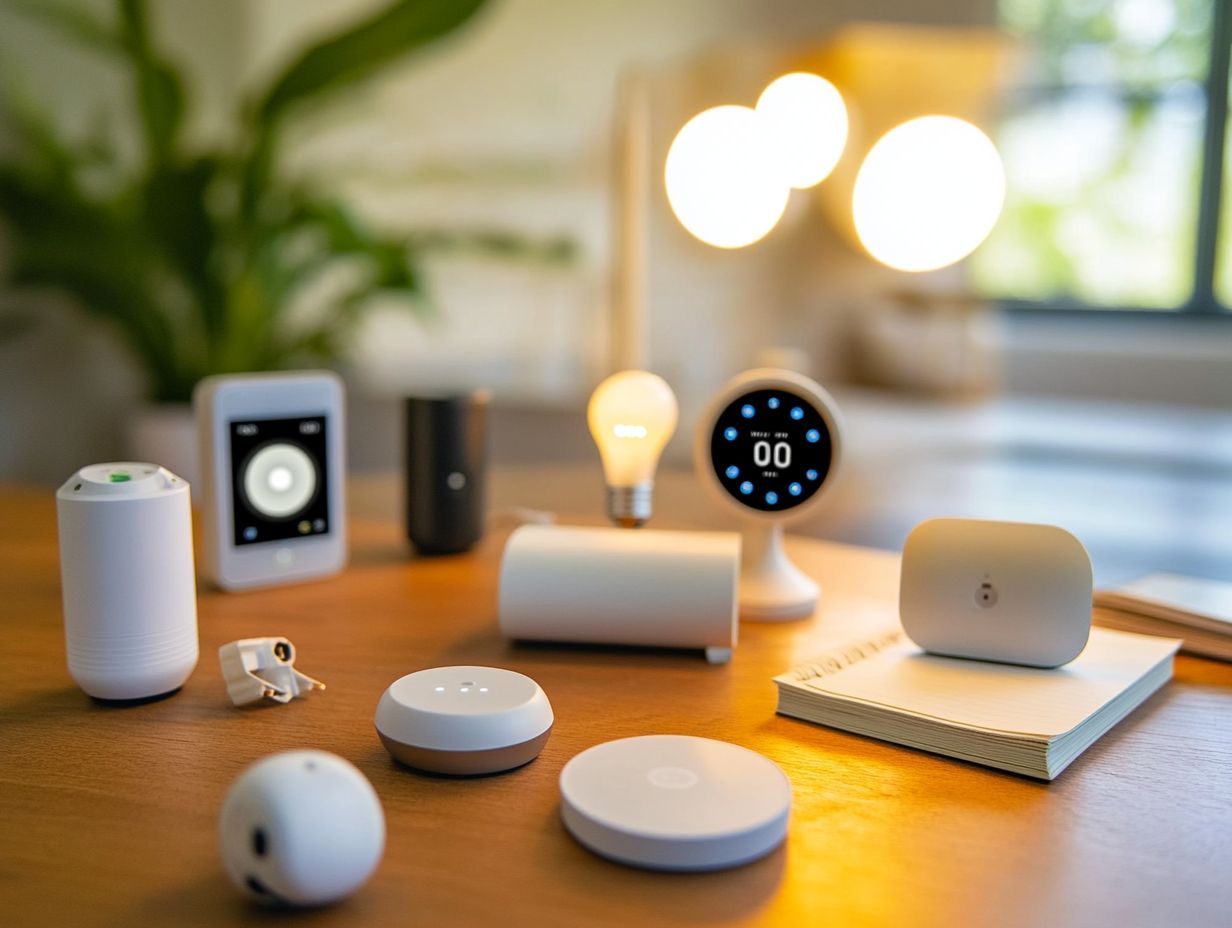
Optimizing your settings and usage habits is essential for minimizing energy consumption across all your smart devices at home. By adjusting parameters like heating and cooling schedules and taking advantage of voice commands through platforms such as Amazon Alexa or Google Assistant, you can manage your energy consumption more effectively.
Smart thermostats are particularly impressive; they learn your behavior over time and automatically adjust temperatures based on when you re home or away, preserving energy without sacrificing your comfort. Smart thermostats that can tell if someone is home can help save even more energy.
Similarly, schedule your smart appliances, like dishwashers and washing machines, during off-peak hours to lower your energy bills. Integrating smart lighting systems that allow you to set timers or utilize motion sensors can also help you prevent unnecessary electricity use. Using smart power strips can further reduce standby power consumption.
Ultimately, by being mindful of how you use your devices and embracing the convenience of virtual assistants for real-time monitoring and adjustments, you can achieve significant energy savings while contributing to a more sustainable environment. Utilizing smart home hubs like Samsung SmartThings can further streamline your energy management. For more insights, explore the effective use of smart sensors for energy savings.
Benefits of Choosing Energy-Efficient Smart Devices
Choosing energy-efficient smart devices offers many benefits. You can save money and help the environment.
These devices often come with ENERGY STAR certification, which means they use less energy than standard models.
When you invest in energy-efficient appliances and automation systems designed to reduce energy consumption, you lower your energy costs and play a vital role in fostering a sustainable future. You also help diminish your carbon footprint.
Incorporating smart home technology, like connected devices, can enhance these benefits even more.
Saving Money and Reducing Environmental Impact
By choosing energy-efficient devices, you can significantly cut down on your energy bills while reducing your environmental footprint.
Embracing smart home technology such as energy-efficient smart thermostats and LED bulbs plays a pivotal role in unlocking savings and fostering sustainability.
Consider smart thermostats that automatically adjust temperatures based on occupancy. Pairing them with smart plugs allows you to monitor and control energy usage for various appliances, ensuring they re powered only when necessary.
Using a mobile app for real-time control can further enhance your energy management.
These innovative technologies not only lower your utility costs but also minimize wasteful energy consumption, helping you achieve a reduced carbon footprint.
When you add integrated solar panels equipped with smart inverters, you amplify these benefits, allowing you to harness renewable energy while spreading the initial costs over time through attractive tax incentives.
By integrating these smart solutions into your home, you not only save money but also contribute to a healthier planet. Start your journey towards sustainability today!
Embracing smart home products, like smart sprinkler systems and water management solutions, can further enhance your home’s sustainability.
Frequently Asked Questions
How do smart home hubs integrate with other devices?
Smart home hubs, like Samsung SmartThings or Flo by Moen, serve as the central point for connecting various connected devices in your home. They enable seamless communication and automation between smart home technology components, ensuring streamlined energy management and enhanced home security.
What are energy-efficient smart devices?
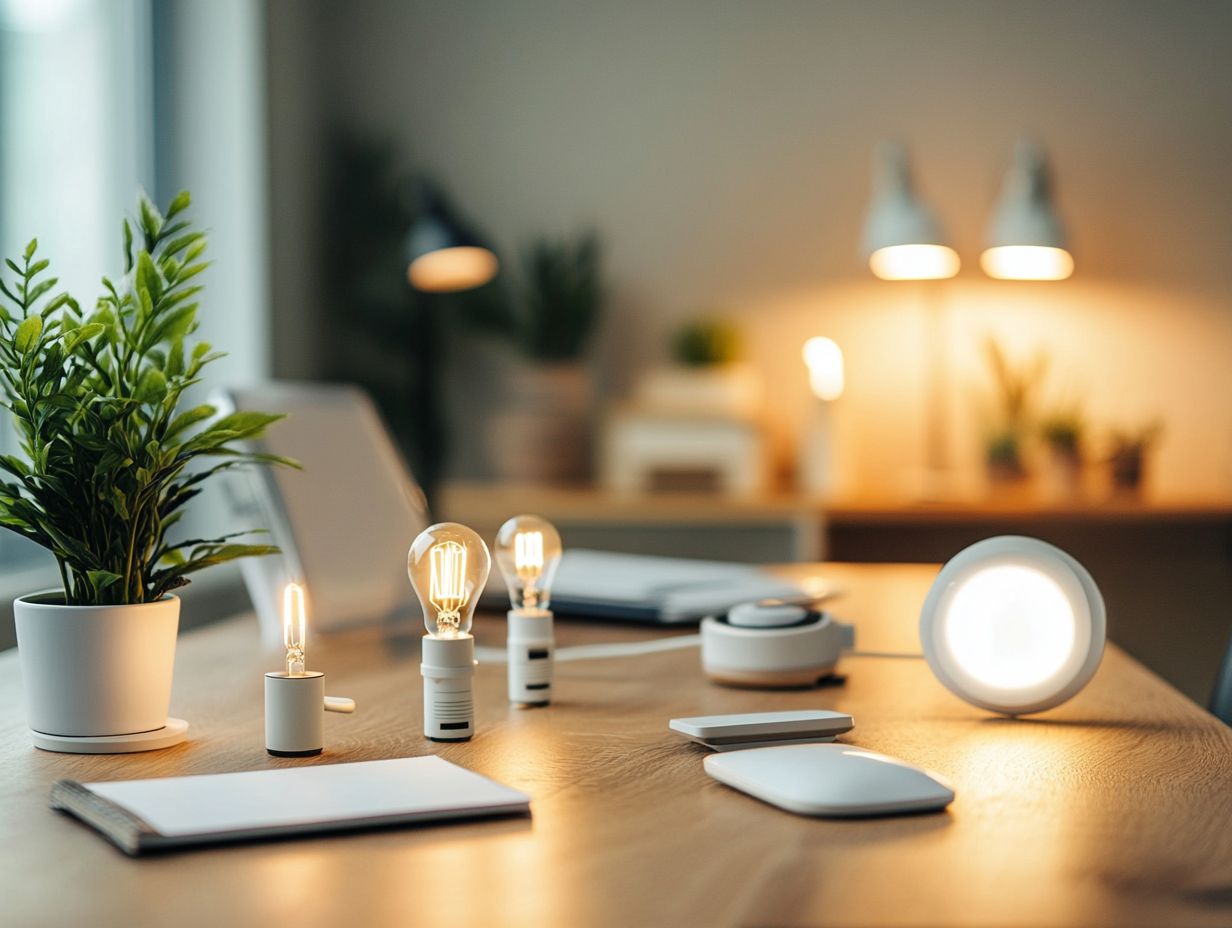
Energy-efficient smart devices are electronic devices designed to use less energy while still providing the same level of functionality. They come equipped with energy-saving features and technologies to help reduce energy consumption and save on electricity bills.
These devices are often part of comprehensive energy management systems.
Why is it important to choose energy-efficient smart devices?
Choosing energy-efficient smart devices is important because it helps reduce energy consumption, benefiting both the environment and your wallet.
These devices typically have a longer lifespan and require less maintenance, saving you money in the long run. Many of them come with ENERGY STAR ratings, ensuring their eco-friendly nature.
How do I identify energy-efficient smart devices?
You can identify energy-efficient smart devices by looking for the ENERGY STAR label. This label indicates that the device has met specific energy efficiency standards set by the government.
Check the device’s energy consumption ratings and compare them to similar products.
Reviews on platforms like McGraw Realtors can also be helpful.
What are the best energy-saving features to look for in smart devices?
Some of the best energy-saving features to look for in smart devices include automatic power-off or standby modes when not in use, adjustable brightness and timer settings, and compatibility with smart home systems that allow for remote control and scheduling.
Integration with voice assistants can also enhance the user experience.
How can I compare the energy efficiency of different smart devices?
To compare the energy efficiency of smart devices, check their energy consumption ratings. You can also use online energy calculators or read reviews for insights on their energy-saving features.
Platforms like Ecobee and Nest offer excellent comparisons to help you find the best option.
Are all energy-efficient smart devices expensive?
No, energy-efficient smart devices come at various price points. While some may have a higher upfront cost, they often save you money on electricity in the long run.
You’ll find many affordable options with valuable energy-saving features.
Brands like Philips Hue and Rachio provide cost-effective solutions that help reduce energy consumption.

